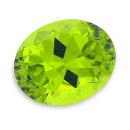|
|
|
|
Click on a letter above to view the list of gems. |
|
|
|
|
|
Peridot
(variety
of Forsterite; Olivine Group) |
|
| Chemistry: (Mg,Fe)2SiO4 [Magnesium Iron Silicate] | |
| Forsterite:
Discovered
in 1824;
IMA
status: Valid (pre-IMA; Grandfathered). | ||
|
| ||
|
Classification |
|
|
| |
|
Silicates | |
|
8/A.04-10 | |
|
|
9 : SILICATES (Germanates) |
|
Related to: |
Olivine Group. Fayalite - Forsterite Series. Forsterite - Tephroite Series. The magnesium analogue of Fayalite, Tephroite and Calcio-Olivine. Polymorph of Ringwoodite and Wadsleyite. |
|
|
|
|
Crystal Data |
|
|
|
|
|
In euhedral or subhedral crystals, typically thick, with striations parllel to elongation, with wedge-shaped terminations, to 17 cm. Commonly granular or compact massive. |
|
|
On [100], [011], [012] |
|
|
|
|
|
Physical Properties |
|
|
|
|
|
[010] Perfect, [100] Imperfect |
|
|
Conchoidal |
|
|
Brittle |
|
|
7.0 |
|
|
3.275 (g/cm3) |
|
|
None |
|
|
Not Radioactive |
|
|
|
|
|
Optical Properties |
|
|
|
|
|
Yellowish Green, Olive Green, Greenish Black, Reddish Brown |
|
|
Transparent to Translucent |
|
|
Vitreous |
|
|
1.635 - 1.772 Biaxial ( + ) |
|
|
0.0330 - 0.0420 |
|
|
Relatively Weak; r > v or r < v |
|
|
None |
|
|
|
|
|
Occurances |
|
|
|
|
|
Geological Setting: |
In mafic and ultramafic igneous rocks and thermally metamorphosed impure dolomitic limestones. |
|
Common Associations: |
Amphiboles, Antigorite, Augite, Brucite, Calcite, Chromite, Corundum, Diopside, Dolomite, Enstatite, Magnetite, Phlogopite, Plagioclase, Spinel. |
|
Common Impurities: |
Cr, Fe |
|
Type Locality: |
Peridot: Prehistoric; Forsterite: Monte Somma, Somma-Vesuvius Complex, Naples Province, Campania, Italy |
|
Year Discovered: |
Peridot: Prehistoric; Forsterite: 1824 |
|
View mineral photos: | |
|
|
|
|
More Information |
|
|
|
|
|
|
Mindat.org
(Peridot) |
|
|
|
|
Peridot is not a recognized mineral name. It's hard to believe that Peridot is the equivalent of a trade name, not a recognized mineral name since it is one of the most popular and well known gems in the world. Peridot has been a popular gem throughout history. Peridot
is available from many localities worldwide including
these well known sources: Mogok, Sagaing District, Mandalay Division, Burma
(Myanmar); St John's Island (Zagbargad; Zebirget; Topazios), Red
Sea, Egypt; Naran-Kagan Valley, Kohistan District, North-West
Frontier Province, Pakistan; and Peridot Mesa, San Carlos, San
Carlos Indian Reservation, Gila Co., Arizona, USA |
|
|
We
have not photographed our Peridot gems. Please
check back soon. |
